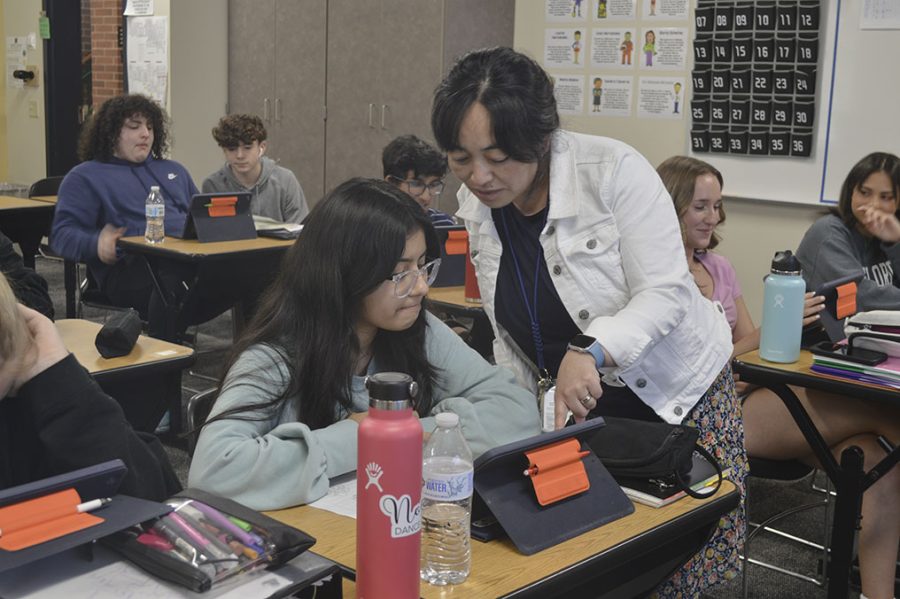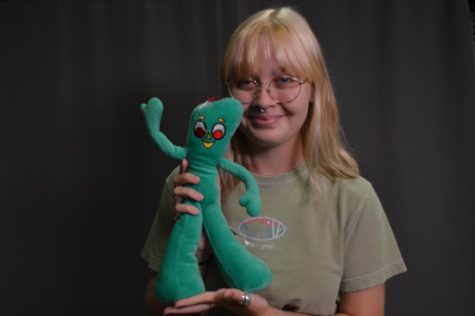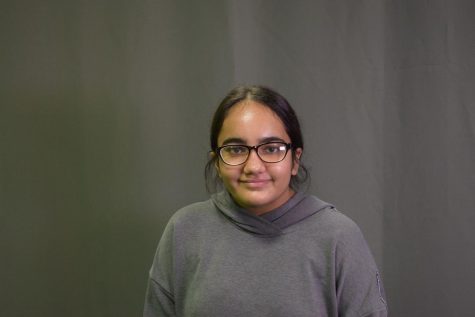Teaching for the People: A first-year Spanish teacher is creating a sense of community at NHS
Photo by Avery
Hoshiko’s class is interactive. She likes to be able to help students individually.
June 6, 2023
You can see her from a mile away. Through the crowded hallways of high schoolers frantically pushing through to get to their next classes, you spot a flash of color. Sporting a brightly colored skirt, she is practically illuminated in the bustling walkway. She stands in front of her classroom door with a bright smile on her face as her hand moves back and forth swiftly, waving at passers-by. She hasn’t been here for even a year, but her students believe she’s already bringing a sense of comfort to her side of the school.
Karina Hoshiko-Oyama is a first-year Spanish teacher at NHS, and although she has now created a home in Noblesville, her story begins in Mexico, where she grew up.
“My family is from Japan [and] my grandparents moved from Japan to Mexico before World War II. I grew up in Mexico until I was 20 and we moved to the U.S. because of my husband’s job,” Hoshiko said.
In 2019, there were an estimated 76,000 people of Japanese descent residing in Mexico, according to the Japanese Ministry of Foreign Affairs. In that same year, Mexico’s total population consisted of 125.1 million people. Individuals of Japanese heritage, such as Hoshiko, made up a mere six percent of Mexico’s population. Growing up in Mexico, Hoshiko could not help to feel ostracized because of her ethnicity.
“I was the only Asian in my whole school. When you are little, you want to fit in, so I didn’t like my background,” Hoshiko said. “I know exactly how [it feels] when you don’t fit in or people don’t understand that you have a different way of doing things.”
When Hoshiko first moved to the U.S., she lived in Michigan and was a stay-at-home mom. However, as she began to volunteer at her child’s school, she found that this experience sparked a new interest in her.
“I started working as an I.A. [instructional assistant] in elementary, and I fell in love with all of the kids. I did my teaching program, got my license, and when I saw this opportunity, I just took it,” Hoshiko said.
This past year, Hoshiko was introduced to NHS’s Asian Student Union (ASU) through an invitation to become a sponsor from former ASU president senior Olivia Chingis. The ASU is a student-led group that celebrates the many Asian cultures represented at NHS. Through participation in club meetings, games, and after school events, the ASU hopes to create a community for Asian students at the school. It was here that Hoshiko found what had perhaps been missing from her own elementary days in Mexico: a sense of belonging.
“When Olivia reached out to me and [told me that] the main purpose of the club was ‘To have a place to be us,’ that’s when [I knew] I was in,” Hoshiko said.
Madel Presto, a math teacher, was the sole sponsor of the ASU when it was first founded. But when Hoshiko arrived, Presto became a co-sponsor.
“We clicked right away. I admire her so much,” Presto said. “You can tell she really cares about her students and wants the best for everyone. I am lucky to get to work with her.”
Overseeing the ASU has been an enlightening experience for Hoshiko. She admires the members’ ability to learn and grow together.
“My favorite part is watching them work together and [seeing] how proud they are of their families and how willing to try new things they are,” Hoshiko said. “They are always helping each other and learning from each other.”
Junior Julie Ngyuen, who has been an ASU member since its founding and currently serves as the club’s president, believes that Hoshiko has impacted her experience in the ASU.
“Ms. Hoshiko inspires me to be open-minded and try new things. She is always asking ASU members about restaurants specific to their culture so she can go try them out,” Nguyen said. “She creates an environment for students to freely express themselves and feel safe.”
Hoshiko approaches teaching Spanish through a lens similar to that of the ASU — in a way that celebrates culture. In her teaching, Hoshiko focuses on more than just the language and aims to encapsulate the entire culture of Spanish speaking communities.
“There’s more than just the language [to learn] — it’s cultural things, how they do things, how they eat. It’s learning from different people, different cultures, different countries,” Hoshiko said.
Hoshiko is not blind to the fact that learning a second language can be a daunting task for many students. She finds unique ways to keep students engaged and entertained while also learning Spanish.
“We [play] a lot of games. Kids are very competitive, so when they are struggling, I make teams so that way they are learning and not just sitting down and doing worksheets,” Hoshiko said. “We [also] do a lot of movement and dancing. I try to make it fun.”
Freshman Atlas Spurlock finds that Hoshiko’s immersive teaching style does wonders for her students. Hoshiko uses both traditional teaching and interactive games to engage her students.
“She jokes with us, and goes along with our dumb bits. She’s not super uptight, and can laugh with us all the time,” Spurlock said. “We play a lot of Gimkits for the competition aspect while still learning things and memorizing them. We do them almost every class, and with how fun it is, it doesn’t even feel like learning when it most definitely is.”
In addition to her teaching, for Spurlock, it’s Hoshiko’s determination and connection with her students which sets her apart.
“She’s very connected with us and tries to get to know us rather than just teaching us. It’s really amazing just being around her, she automatically lifts up our moods,” Spurlock said. “Even when not everyone is interested, she doesn’t give up and it’s really encouraging.”
Hoshiko understands that learning a second language can be difficult — she understands how trying something new can feel uncomfortable at first. But, she stresses that it requires patience, dedication to learning, and sometimes failure to succeed in learning another language.
“You can do this. You can learn new things and it’s okay to make mistakes,” Hoshiko said. “It’s okay to not know things sometimes. You are learning from your mistakes.”
WHY LEARN A SECOND LANGUAGE?
Two upper level Spanish teachers at NHS, Anthony Crist and Marc Slain, believe that the benefits of learning a second language can help set an individual up for success in the world.
- EARNING POTENTIAL: “There is an earning potential that bilinguals have over monolingual professionals. This earning potential can be somewhere between five and 20 percent more over the course of a lifetime,” Spanish teacher Anthony Crist said. “This can translate into hundreds of thousands of dollars over the course of a career.”
- TRAVEL: “The greatest joy that I get out of being proficient in a second language is our travel opportunities. I get to break out of the ‘I’m a tourist’ and I get to interact with more people and get to have a more personalized experience through travel,” Crist said. “For younger people who are going to go into university, you have more opportunity for study abroad so you don’t have to stay here in the United States — you can travel all over the world and seek out other educational opportunities.”
- EMPATHY: “By learning another language, you learn how a different group of people developed a complex language that is equally complete and complex as your own language, and you respect a bigger world,” Spanish teacher Marc Slain said. “You find out how the mind works, how civilization works, how different people develop and think differently and how they communicate in their language. It’s the beauty of diversity and thinking of all the different languages that are complete and complex.”




